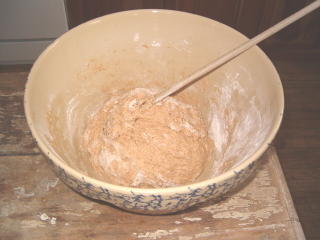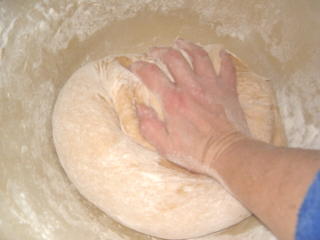The last steps of baking bread are to shape the loaves, let them rise a final time, bake, and eat.
When the dough has risen in the bowl about 45 minutes it will look like the classic description “doubled in bulk”. That 45 minute figure is a flexible, of course, but if you let it rise too long, the yeast will exhaust itself and your loaves won’t rise so well. In a hurry, I have started shaping loaves as soon as there was an observable rise and that works out OK, too.
Take the whole pile of dough and lay it out on a floured bowl. Flour your rolling pin and then roll the dough out flat, being sure to pop the air bubbles that turn up at the edges. You don’t need to roll it paper thin, but you need to eliminate those bubbles because they will end up as voids in the finished loaves. After the bubbles are gone, fold the whole thing in half, fold it in half again, then one more time into a wedge shape. Roll the dough up starting at the point, and then let it rest while you grease your pans.
This recipe fills four 5 by 8 inch bread pans or you can use three 5 by 8 and two 3 by 5 inch pans. Cut the lump of dough into fourths and then cut one of the fourths into two hunks of dough for the kiddy pans. If you are baking with kids, let them grease their pans and then let them take turns rolling out their dough and putting it in their pans. Kids will do what they do and be happy with the results; adults will want to take a more methodical approach.
Roll out one piece of dough at a time into an irregular rectangle, still looking to get rid of bubbles. Roll the rectangle up tightly from the narrow end, and then fold the ends of the roll under so that the cylinder you have left is the same length as the pan. Lay the loaf into the pan with the seams down and then shape your other loaves the same way.
I used to let my loaves rise on the counter under a damp dishtowel, but I found that the dishtowel often stuck to the dough, causing it to fall again before I got it into the oven. Now I set all four loves side by side on the middle oven rack and let them rise in the cold oven. If you have kneaded well, they will rise for quite a while. When you have more experience you can try for giant loaves. The first time just get wait until they have filled the sides of the pan and rounded an inch or two over the top of the pan. After about an hour, I check them and if they look nice and plump I turn the oven on to 350 degrees and set the timer for 40 minutes. (If they are going into a preheated oven they only need 35 minutes.)
Lately I have been using the timed cook feature on my oven to start the bread after I have left the house. This is only a good idea if there is going to be someone home at the end of the cook time to take the bread out of the pans, as it will sweat and turn mushy if it is left to cool in the pans. My teenagers love it when they are home alone and suddenly smell bread baking.
Bread is done when you turn it out of the pan and the bottom of the loaf looks golden and sounds a little hollow when you tap it with your knuckles. If you have an instant read probe thermometer the internal temp should be about 190 degrees.
Cut bread with a bread knife, that is a serrated knife. The serrations make the knife rip instead of crushing. Cooled bread is easier to cut, but everyone wants to eat fresh bread out of the oven, even if the loaves get mashed in the process.
When the bread has completely cooled, you can put it into plastic bags for storage.
If you make this bread recipe with all white flour it is very much like the bread that Grandma Bunny used to make. I have often wondered exactly why my grandmother gave me a book about baking bread instead of inviting me into her kitchen to show me. Grandpa was the vocal half of their marriage. Even though Grandma Bunny had been a central figure while I was growing up, after she died I found that I actually knew very little about her. She shunned cameras, so I had no photos. She had never told stories about her childhood or about herself at all. Even her hometown of Dewdrop, Pennsylvania had been flooded when the Kinzua Dam was built.
Grandpa Lee had earned an engineering degree at University of Michigan and launched a successful civil engineering firm. Until I was 5, he also ran a sand and gravel company from a pit about half a mile behind our house. He was legendary for the “silver tongued speeches” he used to persuade the townships of our county and the adjoining one to build a regional water system. He was also quite at home riding a construction crew. Unlike Bunny, Lee told everyone about his life and experiences and for his grandchildren it was usually to illustrate how little we knew and how easy our lives were in comparison to his.
I think now that Leon was frustrated that his wife didn’t “hop to” on his command the way the rest of the world did. Grandpa often argued with her about baking bread, saying that if you counted up the cost of the ingredients and the electricity to run the oven it would surely be cheaper to just buy bread. She didn’t argue with him, but she didn’t stop baking, either. Still, I recall that Grandpa’s opinion was that it was a waste of my time to learn to bake bread, that I should learn more important things. (This was in the late 1960’s, when it was still an oft repeated prediction that in the future people would not bother to cook and eat at all, but would get all of their nutrients from vitamins.) Grandma countered in her quiet way; I knew right away that she had carefully picked out the book she gave me and it did start me on a lifetime of baking bread.
The conversations with Grandpa when he was worrying about people knowing how to feed themselves came well after Bunny’s death. A much as he had criticized her during her life, he missed her terribly and spoke of her like a saint. Living alone, he had time to really appreciate what it takes to feed oneself. He baked beans over and over again but they never came out the way that Bunny used to make them. His curiosity about food extended to wondering about where it came from. At this time I was learning to keep bees. Grandpa, now in his eighties, was fascinated to hear how bees forage for nectar and pollinate crops. He asked over and over again how I would make the bees collect the sort of nectar that I wanted; it was a revelation to him that you couldn’t direct them, but you could simply take advantage of what they were going to do anyway.
These were the last conversations I had with Grandpa. I had moved to Hawaii when he started becoming sick and disoriented. Perhaps his personality change was the beginning of his decline, but that short interval of conversations made more of an impression on my than the years of lectures that came before.


